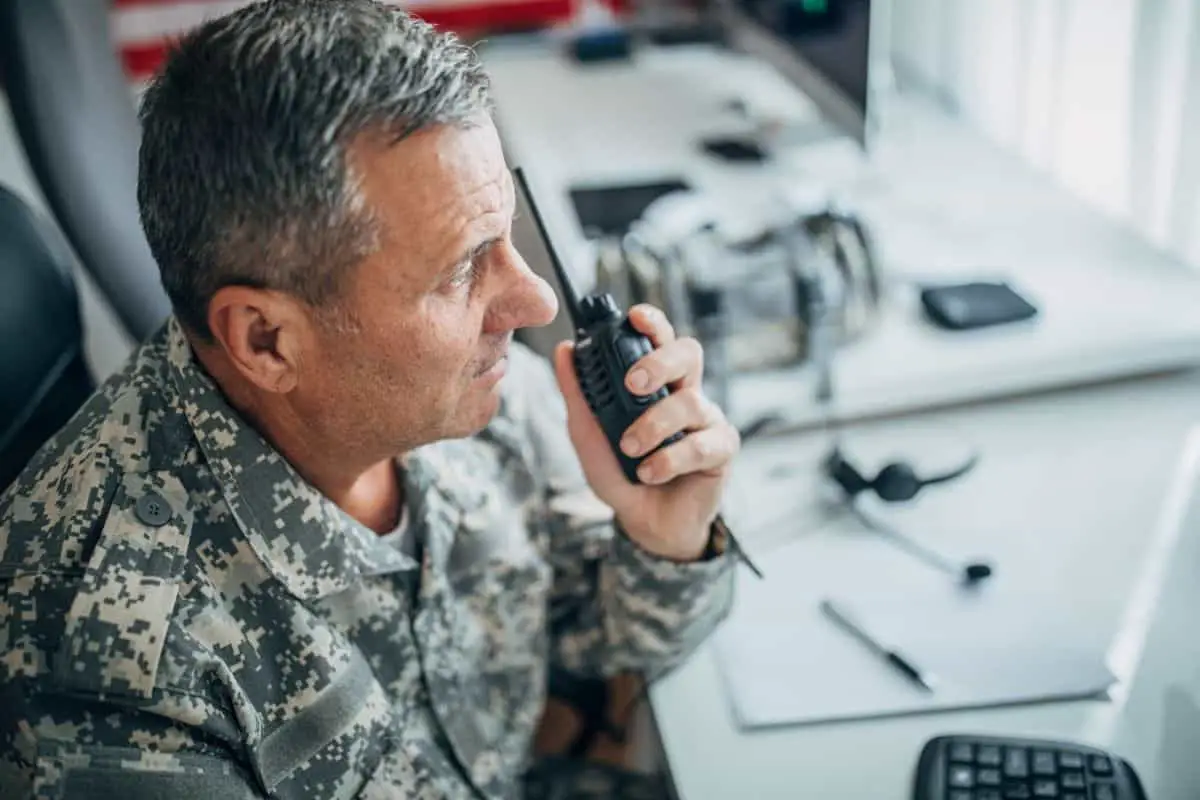Walkie-talkies are an important form of communicator that can be used in a variety of situations.
As they don’t rely on network connectivity as cell phones do, they are a safe and secure way to stay connected even in remote areas that phones can’t reach.

To ensure that you stay connected when using a walkie-talkie you need to know their range. In this article, we will look at how walkie-talkies work and how far they can reach.
What Is The History Of Walkie Talkies?
Let’s begin by looking at how walkie-talkies came to exist. They were originally invented in the mid-1930s, with the first portable two-way radio signal being created by Donald Hings in 1937.
The first device that was called a ‘walkie-talkie’ was the Motorola SCR-300 which was developed by the US military in 1940 for use in World War II.
This was a backpack communicator and the first handheld walkie-talkie was the SCR-536, also made by Motorola, in 1941.
How Do Walkie Talkies Work?
As walkie-talkies don’t use phone wires or networks, exactly how do they work? Understanding how a walkie-talkie works will help us understand how far they can reach.
Each walkie-talkie has a number of components, including a mic, speaker, battery, and antenna.
When you press the PTT (press to talk) button and speak into your walkie-talkie, your voice is converted into a radio signal.
This electromagnetic signal travels at the speed of light and is picked up by any walkie-talkie in range that is on the same radio frequency.
Some walkie-talkies can access several different frequencies so you need to tune into the correct one to receive the signal.
In the United States, the radio signals are broadcast on either Family Radio Service (FRS) or General Mobile Radio Service (GMRS) frequencies.
There are also frequencies reserved for corporate use, which are called the Business Band. These frequencies are limited in number, so you can get interference or pick up random communications.
Modern walkie-talkies have some features to try and prevent this from happening.
What Can Affect The Range Of A Walkie Talkie?
There are a variety of things that can affect the range of your walkie-talkie and reduce how far it can reach. One of the largest factors is the flatness of your surroundings.
Radio signals travel in straight lines, so whenever they have to move through objects in their way, the objects absorb some of the signals and reduce the range.
This means that natural features such as hills and wooded areas can reduce how far your signal travels, as can man made objects such as buildings.
Your signal will travel farther across flat and open land than it will in a built-up urban area.
The weather can also negatively affect how far your signal will reach. Clear skies are the optimum conditions for the strength and range of walkie-talkie signals.
However, weather conditions such as fog, storms, rain, and strong gusts of wind can reduce your range.
Unfortunately, there is nothing you can do about poor weather conditions, but it is worth bearing in mind before you set out with your walkie-talkie.
How Far Can Walkie Talkies Reach?
As we’ve just learned, the distance a walkie-talkie can reach will depend greatly on your surroundings.
If we presume that the walkie-talkie is being used in a flat and open space, then it is common for even the most cost-effective walkie-talkies to have a range of five miles.
In urban settings, these five miles can be reduced to as little as 500 meters. Some walkie-talkies that are designed specifically for long distances can reach over 30 miles when used in open areas.
How Can I Increase My Walkie Talkie Range?

Thankfully, there are numerous ways you can increase the range of a walkie-talkie if it isn’t performing as well as you need.
Some of these are quick and easy fixes whereas others are factors you should consider before you buy.
Use A Repeater
A repeater or booster is a device that helps extend your range. It receives the signal from your walkie-talkie and then retransmits it with increased power to extend the range.
They should be installed at an elevated height so that you will get the maxim effect from their boost.
Charge Your Battery
If your battery is running low, it can affect the strength of your signal. The more wattage there is behind your signal, the stronger it will be.
Fully charge your walkie-talkie before you begin your hike or activity.
If your walkie-talkie uses rechargeable batteries, be aware that the performance of these will reduce over time so it’s best to check they are still in good working condition.
Signal Strength
As we mentioned earlier, walkie-talkies can broadcast on either FRS or GMRS frequencies.
Walkie-talkies that use FRS frequencies broadcast at a wattage of half a watt to two watts, whereas walkie-talkies on GMRS frequencies broadcast at up to five watts of power.
In general, higher wattages provide stronger signals, and this results in a longer range.
Walkie-talkies on a GMRS frequency will have a stronger signal but be aware that these may require you to obtain a license to use.
Check The Antenna
Unfortunately, changing an antenna on a walkie-talkie is near impossible so this is something you should take into account when you choose which walkie-talkie to buy.
Raising an antenna increases your range, so if range is important, avoid walkie-talkies with short and stubby antennas.
Extending your antenna helps with minimizing obstructions and increasing your signal strength.
Final Thoughts
Numerous factors can affect the range of a walkie-talkie and prevent it from reaching its maximum range.
However, under the optimum conditions, casual walkie-talkies can reach a range of five miles, and premium devices designed for long distances can reach over 30 miles.
Make sure you keep your battery charged and are in a flat, open space to get the most from your walkie-talkie.

